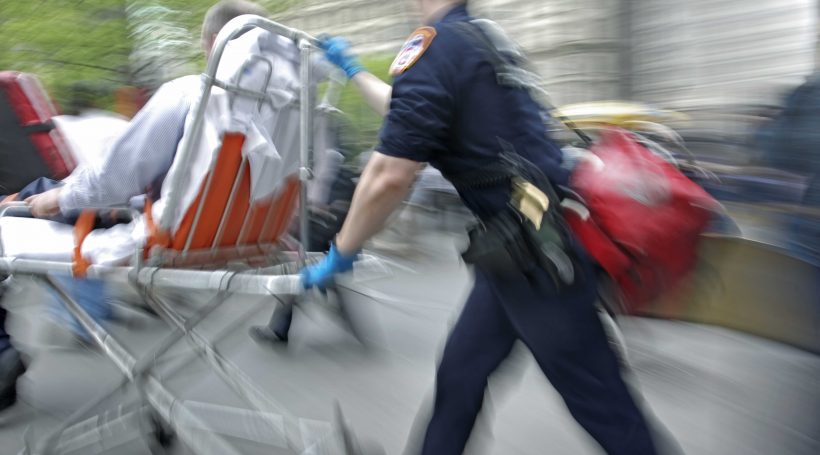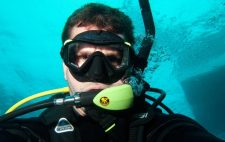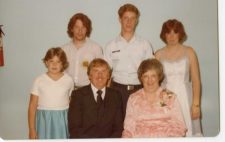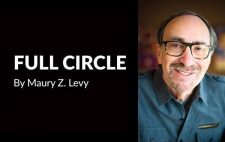When it comes to emergency cardiac care, minutes mean everything. Whether treating a heart attack – which damages the heart muscle – or a full cardiac arrest, in which the heart completely stops, it’s a race against the clock in ambulances and emergency rooms to prevent death and minimize trauma to the body. At hospitals across SJ, treatment advances are saving more time than ever before.
Cold-hearted care
Paul Mass, a 49-year-old father of two small children who lives in Mullica Hill, died March 11 of last year. Robert Ball, 64, who lives in Westmont, died three years ago, on January 9, 2008.
Both men had gone into full cardiac arrest. Mass’ heart stopped beating for at least five minutes. Ball’s stopped for at least 10. They were each resuscitated by paramedics and rushed to SJ hospitals, where doctors induced comas and basically put their bodies on ice, plunging their core body temperatures to 90 degrees Fahrenheit. It is a new treatment that, in the past year, has become a standard emergency room procedure for cardiac arrest patients.
It’s called therapeutic hypothermia, and it is one of the reasons both men are alive today.
Before last year, aside from an elevated cholesterol level, Mass was otherwise healthy. “I never had anything,” Mass says.
A self-employed contractor, Mass doesn’t remember dying, but since that day, he and his wife, Tara, have managed to piece together the story: Mass was exiting the Pine Valley Golf Course in Clementon after making a regular delivery of sand. On the road just outside of the club’s front gate – and out of view – Mass pulled over his truck and stumbled out of the vehicle.
“We think something must have happened then,” Tara says, “because he never parks the truck there.”
Somehow (they’re still unsure) Mass injured himself in the process of exiting the truck, drawing blood. A Good Samaritan, Kevin Driscoll of Hammonton, happened to be driving by and saw Mass bleeding on the ground. He ran to the gate’s guard for help.
A heart attack had triggered Mass’ cardiac arrest. He was rushed to the local ER, then flown to Cooper University Hospital, where – after inducing a coma with sedatives – doctors wrapped him in cooling blankets to rapidly lower his core body temperature and induce hypothermia.
Hypothermia itself is a dangerous condition. When a person’s core temperature drops below 95 degrees Fahrenheit, it impairs the body’s ability to function normally. In short, to preserve heat, body systems slow and shut down. If untreated, painful shivering, mental confusion and death result.
Mass was kept in that state for 12 to 18 hours, then gradually warmed and weaned from the sedatives. At that point, it became a waiting game.
“When – and if – he woke up, then we’d know how he was responding,” Tara says.
If a patient is successfully resuscitated, “half won’t survive to hospital discharge because of the brain injury that results from cardiac arrest,” says Stephen Trzeciak, MD, head of emergency medicine at Cooper and Mass’ physician.
But there is growing evidence that shows inducing mild hypothermia helps improve those odds, so much so that in December 2008, the American Heart Association formally recommended the treatment. Since then, it has been become a standard procedure in emergency rooms across SJ, including Cooper, Lourdes, Virtua, Deborah Heart and Lung Center, and Kennedy University Hospital.
During cardiac arrest the heart muscle completely stops pumping blood, depriving the body its critical oxygen supply. Within minutes, brain damage or death can result.
“In years past, we didn’t know the brain damage from cardiac arrest was treatable. Nobody did,” Trzeciak says.
Ironically, it is the process of restarting the heart and blood flow that causes brain damage. When blood returns to oxygen-starved parts of the body, vital organs and tissues become inflamed. It’s that swelling that causes brain injury, Trzeciak says.
By inducing hypothermia, then slowly re-warming, doctors can now control the inflammation, giving cardiac arrest survivors more of a fighting chance. “After 24 hours, we slowly bring their temperatures back up, cross our fingers and hope they come out of it and have good brain function,” Trzeciak says.
The Paramedic Becomes the Patient
Robert Ball, a recently retired emergency medical technician for the Cherry Hill Fire Department, had used hyperthermia in emergencies before he experienced it firsthand. “I’m 100 percent convinced therapeutic hypothermia gave me back my brain,” he says.
Diagnosed in 2007 with sleep apnea – a condition in which people stop breathing in their sleep – Ball’s doctor had given him a device to counteract it. While he says he usually used the machine while he slept, he didn’t the night he died.
“I was terribly exhausted that night,” Ball recalls. “I didn’t put it on.”
His snoring – a common sign of sleep apnea – was disturbing his wife, Sue, so she left the bedroom to read. Alarmed when she realized her husband had stopped snoring, she returned around 3 am and found her husband in full cardiac arrest, triggered by the sleep apnea. She called 9-1-1.
Ball’s former paramedic partner intubated him, and his first-responder colleagues resuscitated him three times on the way to Lourdes’ emergency room, where his body temperature was cooled to 91 degrees Fahrenheit.
“By inducing mild hypothermia, we make patients just cold enough to decrease inflammation of the brain, but not cold enough to be harmful,” Trzeciak says. While cooled and sedated, doctors can perform other emergency cardiac procedures on the patient. Since Cooper started administering therapeutic hypo-thermia, they’ve treated about 150 patients this way.
“We’ve definitely seen striking cases of improvement,” Trzeciak says. “While we can’t save everybody, we have seen some remarkable recoveries.”
For patients who survive without severe brain damage, hallucinations are common in the early days of regaining consciousness, but it’s not known if that’s caused by the sedation or hypothermia. Mass only remembers a heightened reality – intense focus on the cars outside his window overlooking Interstate 676. Ball recalls frightening images of spiders crawling out of his skin and water pouring down the walls.
“There was also a short little man at the end of my bed. He was there for three days, but I was the only one who could see him,” Ball says.
Both also experienced intense shivering as they came to – a good sign, and how the body naturally generates heat. But the sign their loved ones most anxiously awaited was that moment they knew the brain damage was minimal.
Tara Mass recalls that – in the days before her husband became lucid – she talked while at his bedside with other family members about giving her brother, Todd, tickets for a NASCAR event at Bristol Motor Speedway.
“It was weird when he woke up, because the first thing Paul said was, ‘Did Todd go to Bristol?’ I knew with that – oh my God, he was cognizant,” she says. “I’m not sure how he knew, but he must have heard us talking.”
While both men have suffered short-term memory loss – neither remembers the days and weeks leading up to their deaths – and Ball has some lingering issues with his balance, they have both returned to full, active lives.
Ball travels extensively as a sales representative for a bioengineering company and actively promotes the consequences of untreated sleep apnea.
Mass returned to work five months ago and has a renewed appreciation for his family and the kindness of strangers.
“If it wasn’t for Kevin Driscoll, the paramedics and the doctors, everyone who helped me, I wouldn’t be here,” Mass says. “Every time I pick up one of my kids, it’s like a blessing.”
Saving Precious Time
Even if a patient’s heart has not completely stopped, heart attacks weaken the muscle and must be treated quickly to keep injury to a minimum. New technologies can diagnose and treat patients quickly.
Mark Albert, of Pennsauken, had a run of bad luck with his health last year. He had gone for pre-operative testing for hip replacement surgery, but his EKG (an electrocardiogram, which measures the heart’s electrical activity) showed he’d recently suffered a “silent” heart attack, experiencing none of the telltale symptoms like pain and heaviness in the chest. Two blockages to his heart were found, severe enough that after angioplasty – in which arteries are widened with a balloon and propped open with a stent – he still needed bypass surgery.
But the news only got worse, and Albert had a second heart attack in early January. This time, he felt it.
“I had pain in the side of my chest,” Albert says. “My wife says I never complain about anything, so if I was complaining, there must be something to this.” Driven to Lourdes’ emergency room, he was sent to the hospital’s cardiac catheterization lab for another angioplasty.
A new blockage had formed in one of Albert’s stents, says his doctor, Timothy Morris, DO. It was so bad he couldn’t get the balloon through to place a new stent. That’s when Morris used the excimer laser to open the artery and restore blood flow.
“It had become very calcified. The laser opens up a nice channel through the calcium,” Morris says.
Using a catheter that is about the width of a human hair, Morris says the laser – like with the balloon and stent – is threaded through to the blockage, usually via the femoral artery in the groin.
In less time than it would take to do the standard procedure – using a special drill designed to open arterial blockages, followed by another device that sucks out the clot – the laser “vaporizes the molecules,” with an ultraviolet light, Morris says. “It gets the clot out and opens the vessel at the same time.”
Albert was awake for the laser procedure, needing only a mild sedative. “Dr. Morris explained everything step by step. I watched the whole thing on-screen. It didn’t hurt. You could feel the throbbing of it every time he would blast it.”
Morris says the laser has become his tool-of-choice for angioplasties, having personally done 70 to 80 coronary artery procedures in the last two years, and helping Lourdes regularly meet or beat the American Heart Association’s recommended minimum “door-to-balloon” time of 90 minutes.
An Aspirin a Day – Keeps a Heart Attack Away?
When it comes to heart disease, aspirin has quite the reputation. Medical studies suggest that taking aspirin at the onset of a heart attack can save your life. Others advise men take one baby aspirin every day to keep the heart healthy. But Mark Finch, MD, of The Cardiology Group in Mount Laurel, says it’s not that simple. “There’s no blanket statement here that applies to everyone. It should be an individualized decision between you and your doctor,” he says. “When it comes to aspirin, there are two issues. There’s treatment, and there’s prevention.”
During treatment, aspirin can be a vital tool because of its ability to inhibit the formation of blood clots, says Finch. “If someone’s having a coronary issue, aspirin as a treatment is very important because it has been shown to literally save lives,” he says. It’s especially effective when it’s taken at the first signs of a heart attack. “For example, when paramedics are called to someone’s house for chest pains, they administer aspirin in the field because studies show the quicker you give aspirin, the more benefit it has.”
For as much good aspirin does during a heart attack, Finch cautions that it doesn’t necessarily mean you should be taking it every day. “It really depends on what your risk of coronary artery disease is,” he says. You’re often considered high risk if you smoke, have high blood pressure or diabetes, or have a family history of heart attacks. And even in those cases, you should first consult your doctor about aspirin usage and dosage, notes Finch.
For those not falling into the high-risk category, daily use of aspirin can have serious side effects, including internal bleeding and stroke. “Aspirin can upset people’s stomachs – it can literally cause ulceration,” adds Finch. “If people are not at risk, they should really, really refrain from taking aspirin unless they have a discussion with their physician about whether they’re an appropriate candidate.”














